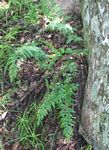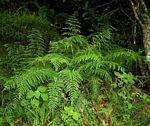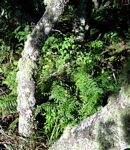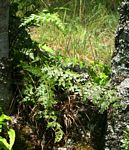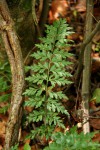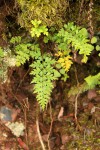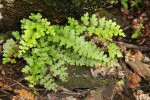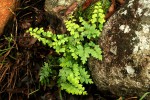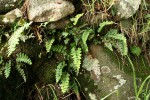Asplenium aethiopicum [Agg]
Selected images: Click on each image to see a larger version and details of the record View all images (16)
Detailed records: Display species records QDS maps by: Google Maps Point records by Google Maps
Species details: Click on each item to see an explanation of that item (Note: opens a new window)
| Synonyms: |
Asplenium adiantoides Lam. Asplenium furcatum Thunb. Asplenium gueinzianum Mett. ex Kuhn Asplenium praemorsum sensu Sim Asplenium schelpei Braithwaite Trichomanes aethiopicum Burm.f. |
| Common names: | |
| Frequency: | |
| Status: | Native |
| Description: |
Rhizome creeping or ascending, up to 7 mm thick. Rhizome scales 3-7 mm long, linear-attenuate, light-dark brown to blackish, entire or with a few hair-like outgrowths, ending in hair-point. Fronds tufted. Stipe 8-40 cm long, dark brown, covered with hair-like scales when young, subglabrous with age. Lamina very variable in size, shape and degree of dissection, 12-64 cm × 3.7-27 cm, strongly 2-pinnatifid to 3-pinnate, ovate to narrowly lanceolate in outline with the basal pair or 2 of pinnae usually reduced in size. Pinnae ovate to narrowly lanceolate, apex acute, sometimes drawn out into a thin, narrow terminal segment; margins irregularly toothed. Pinnules upper surface subglabrous, lower surface sparsely set with twisted scales. Sori linear, 3-14 mm long, set along flabellate veins, sori more than one per lobe, indusiate. |
| Type location: |
|
| Notes: | The extreme variability of this species makes it difficult to distinguish it from others in this group. A. aethiopicum has recently been split up in 4 subsp.(J.P.Roux,2001). We have lumped these for the time being. These subspecies usually grade from one to the other and are hard to distinguish without a strong microscope to examen the spores. All occur in Zimbabwe, subsp. aethiopicum and subsp. dodecaploideum in the east, for subsp. filare and subsp. tripinnatum district are not known (A checklist of Zimbabwean vascular plants, Sabonet Report No. 33, 2004). |
| Derivation of specific name: | aethiopicum: of Ethiopia, a historic name for large parts of Africa |
| Habitat: | Wide variety of habitats, deciduous woodland, high altitude mist forest, riverine forest, evergreen coastal forest. Terrestrial, epiphytic or lithophytic. |
| Altitude range: (metres) | Up to 2140 m |
| Worldwide distribution: | Lesotho, Malawi, Mozambique, South Africa, Eswatini, Zambia, Zimbabwe, tropical and subtropical Africa, Comoro islands, Mauritius, Madagascar |
| FZ divisions: | N,W,C,E,S |
| Growth form(s): | Epiphyte, lithophyte, terrestrial. |
| Endemic status: | |
| Red data list status: | |
| Insects associated with this species: | |
| Spot characters: | Display spot characters for this species |
| Images last updated: | Sunday 25 September 2011 |
| Literature: |
Burrows, J.E. (1990). Southern African Ferns and Fern Allies. Frandsen, Sandton. Pages 246 - 248. (Includes a picture). Burrows, J.E. & Burrows, S.M. (1993). An annotated check-list of the pteridophytes of Malawi Kirkia 14(1) Page 93. Chapano, C. & Mugarisanwa, N.H. (2003). Plants of the Matobo District National Herbarium and Botanic Garden, Zimbabwe Page 5. Crouch, N.R., Klopper, R.R., Burrows, J.E. & Burrows, S.M. (2011). Ferns of Southern Africa, A comprehensive guide Struik Nature Pages 646 - 649. (Includes a picture). Dowsett-Lemaire, F. (1989). The flora and phytogeography of the evergreen forests of Malawi. I: Afromontane and mid-altitude forests; Bull. Jard. Bot. Nat. Belg. 59(1/2) Page 26. Fischer, E. & Lobin, W. (2023). Synoptic Revision of Aspleniaceae (Asplenium, Hymenasplenium) of Rwanda. Phytotaxa 608 (1) Page 9. Jacobsen, W.B.G. (1983). The Ferns and Fern Allies of Southern Africa. Butterworths, Durban and Pretoria. Pages 361 - 362. (Includes a picture). Kornas, J. (1979). Distribution and ecology of the Pteridophytes in Zambia Polska Akademia Nauk Wydzial II Nauk Biologicznych Pages 94 - 95. Roux, J.P. (2001). Conspectus of Southern African Pteridophyta. Southern African Botanical Diversity Network Report 13 Page 160. Roux, J.P. (2009). Synopsis of the Lycopodiophyta and Pteridophyta of Africa, Madagascar and neighbouring islands Pages 76 - 77. Schelpe, E.A.C.L.E. (1970). Pteridophyta Flora Zambesiaca Pages 181 - 182. Vollesen, K. & Merrett, L. (2019). Field Guide to the (wetter) Zambian Miombo Woodland. Part 1 (Ferns & Monocots) GVPedia Communications Page 97. (Includes a picture). Wursten, B., Timberlake, J. & Darbyshire, I. (2017). The Chimanimani Mountains: an updated checklist. Kirkia 19(1) Page 78. |
Other sources of information about Asplenium aethiopicum:
Our websites:
Flora of Burundi: Asplenium aethiopicumFlora of the DRC: Asplenium aethiopicum
Flora of Malawi: Asplenium aethiopicum
Flora of Mozambique: Asplenium aethiopicum
Flora of Rwanda: Asplenium aethiopicum
Flora of Zambia: Asplenium aethiopicum
External websites:
African Plants: A Photo Guide (Senckenberg): Asplenium aethiopicumAfrican Plant Database: Asplenium aethiopicum
BHL (Biodiversity Heritage Library): Asplenium aethiopicum
EOL (Encyclopedia of Life): Asplenium aethiopicum
GBIF (Global Biodiversity Information Facility): Asplenium aethiopicum
Google: Web - Images - Scholar
iNaturalist: Asplenium aethiopicum
IPNI (International Plant Names Index): Asplenium aethiopicum
JSTOR Plant Science: Asplenium aethiopicum
Mansfeld World Database of Agricultural and Horticultural Crops: Asplenium aethiopicum
Plants of the World Online: Asplenium aethiopicum
Tropicos: Asplenium aethiopicum
Wikipedia: Asplenium aethiopicum
